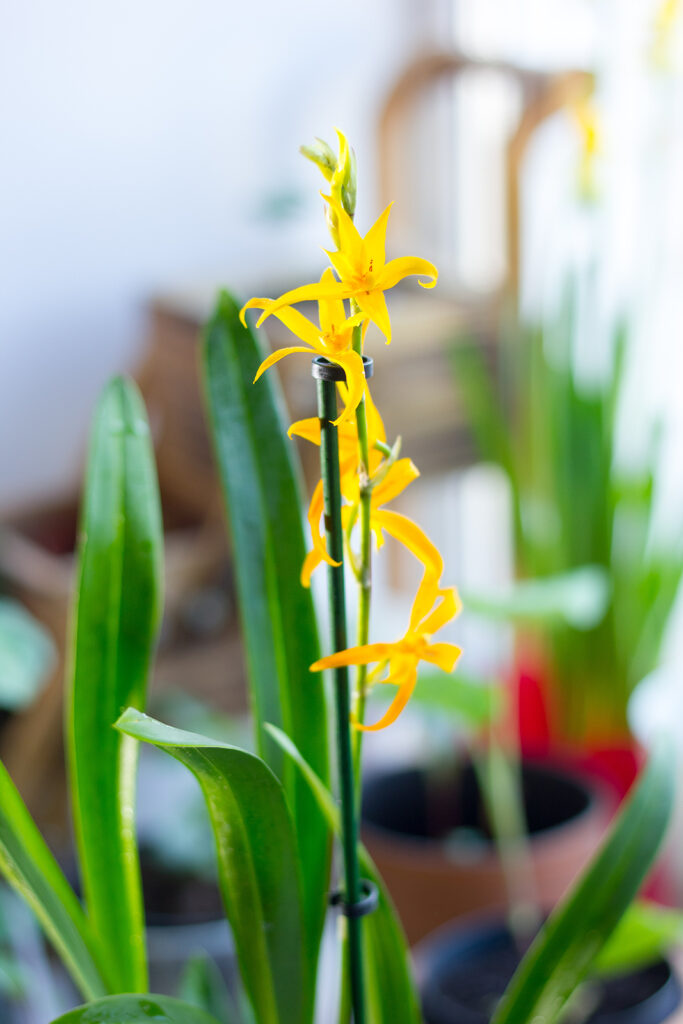Miltonia is a genus of evergreen tree-growing (epiphytic) orchids that bear star-shaped, sometimes fragrant flowers on erect racemes. Miltonia are native to tropical regions of Brazil; a related genus Miltoniopsis is very similar but native to the cool regions of Costa Rica and Peru.
Miltonia commonly have white, yellow, or greenish-yellow flowers; the flowers are often marked or spotted. Leaves are linear or oblong-lance-shaped, thin, and pale to dark green
Miltonia naturally grows in trees. They need an epiphytic soil mix or can be grown on bark.
Miltonia is a genus of 15 species native to Brazil. Miltoniopsis is a genus of species. The two genus can be distinguished by the number of leaves they carry on their pseudobulbs; miltonias bear two leaves per pseudobulb, while Miltoniopsis hold only one.
Get to know Miltonia
- Plant type: Pernnial orchid
- Growing zones and range: In containers of epiphytic soil mix, epiphytically on bark, or in slatted baskets.
- Hardiness: Zones 14-15
- Temperature: Room temperaure or warmer
- Height and width: 9 inches (23cm) tall and wide
- Foliage: 2 linear, oblong, or oblong-lance-shaped slightly, leathery, thin pale do dark green leaves
- Flowers: Star-shaped, sometimes fragrant flowers are produced in usually erect racemes from the bases of the pseudobulbs, at various times of the year.
- Bloom time: Various times of the year; most summer into autumn.
- Uses: Houseplant, tropical gradens
- Common name: Miltonia
- Botanical name: Miltonia
- Family name: Orchidaceae
- Origin: Warm, moist forests in Brazil

Where to plant Miltonia
- Light: Medium light; foliage will sunburn if it receives too much light. Miltonia must have partial shade in summer if grown outdoors.
- Soil: Use an epiphytic soil mix or grow on bark or in a slatted bakset.
When to plant Miltonia
- Grow Miltonia outdoors only in tropical or subtropical conditions. In cooler regions, grow Miltonia in a warm greenhouse or as a houseplant indoors.
Planting and spacing Miltonia
- Space Miltonia 9 inches (23cm) apart.
How to water and feed Miltonia
- Water: Water Miltonia freely durng the summer; keep the medium moist. Mist Miltonia once or twice daily.
- Feeding: Feed Miltonia every third watering with a low nitrogen all-purpose orchid food.
Miltonia care
- In winter, Miltonia can take full light and should be watered only moderately.
- Divide Miltonia when the plant fill the pot or flows over the sides.
Miltonia pests and diseases
- Miltoinia is prone to aphids, spider mites, and mealybugs.
- Bacterial soft rot and brown rot, cymbidium mosaic virus, basal stem rot, and leaf rot are common.
Miltonia propagation
- Divide when the plant fills the pot and spill over the sides.
Miltonia varieties to grow
- Miltonia ‘Bluntii’ (M. clowessi x M. spectabilis). Epiphytic hybrid orchid grow 9inches (23cm) tall and wide with elongated pseudobulbs and linear leaves, 6inches (15cm) long; produces racemes of 3-7 star-shaped, fragrant, light yellow flowers in autumn; flowers are 3 inches (8cm) long, with red-brown markings, white lips, and purplish crimson bases.
- M. candida, syn. Anneliesia candida. Epiphytic orchid grows 9 inches (23cm) tall and wide with oblong-ovoid pseudobulbs and linear-lance-shaped leaves, 12in (30cm); produces racemes of 2-8 star-shaped, greenish yellow flowers in autumn; flowers are 3inches (8cm) across, spotted chestnut-brown and yellow, with lips sometimes flushed white or pink.
- M. clowesii. Epiphytic orchid grows 9 inches (23cm) tall and wide with narrowly ovoid pseudobulbs and linear leaves, 12in (30cm) long; bears long racemes of 3-7 star-shaped, greenish yellow flowers in autumn; flowers are 2inches (5cm) across, each barred chestnut-brown, with white lips tinted violet-purple at the bases.
- M. phalaenopsis. see Miltoniopsis phalaenopsis.
- M. roezlii. see Miltoniopsis roezlii.
- M. spectabilis. Epiphytic orchid grows 9 inches (23cm) tall and wide; produces elongated pseudobulbs and linear-oblong leaves, 6 inches (15cm) long; bears white, red, or purple flowers, 3 inches (8cm) across, with red or purple lips, each with 3 yellow ridges at the base; flowers are borne singly or occasionally in pairs. Cultivar var. moreliana bears deep plum-purple flowers with deeply veined, rose-streaked and shaded lips.















